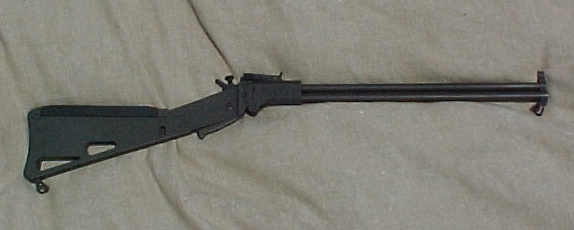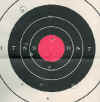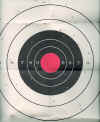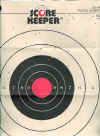The Springfield M-6
a follow-up report
by John Dunn
created on 03 August 2003
(Click on the "thumbnails" and a larger image opens in a new window.)

After seeing AK Church's article on the Springfield Arms M-6, not to mention being an editor's assistant on that very project as well as seeing his prized combo gun in the flesh, it grew and grew on me that I had to have one of these things of my own. They are much talked-about in the online outdoor survival discussion forums that float around the internet. The Scout's light weight and versatility as a survival arm makes it a great "truck gun" (AND local legalities--be sure to check these!), part of a pilot or boater's survival kit or backpacker's companion (depending on where you do your hiking of course).
Mr. Church's article needs no further embellishment so this addendum will focus primarily on target performance. However for another excellent narrative I would also direct the reader to Vshrake's article on the M-6 Scout. His gun is of the newer Czech manufacture with the stainless finish. And for those interested in the .410 for it's own sake, have a look at this British site as an excellent overview for .410 shotguns in general.
The above photo is a shot of my own, recently acquired M6. It was found as a listing on www.gunbroker.com and though the auction was already ended, the seller (who by coincidence turned out to be a regular on our Savage 24 discussion board) was kind enough to sell it to me anyway at the opening bid price. He had barely fired it at all before selling it and offered me a good price on it so I was very lucky to make such a find.
I'm told the finish is phosphate (it appears as a lighter gray color than in that photo) and the lockup is very nice and tight. It is believed that this is an even earlier gun than the one in the main article by Church, perhaps a 1985-86 gun.

After that picture was taken I embellished it with a barrel wrap of bright yellow emergency-rescue type paracord. "Why on Earth did you use canary yellow instead of OD green" you ask? Two reasons, both of practicality: #1 it was what was available at the time, and #2, this is a survival/emergency weapon, not a super ninja assault blaster. As such it seemed to make sense to make the paracord wrap from a source intended for emergency purposes rather than camouflage. It serves as both a helpful fore-end and a source of cord for shelter-building. If "TEOTWAWKI" is not your concern and one used this gun while waiting for rescue rather than while avoiding it, then why not use something more visible? At least that was the rationale I came up with.
Further, this is a slightly older gun which Springfield doesn't make anymore. As such it came in the fold-only, non-takedown, trigger guard-less version. That is, rather than a removable take-down pin it came with a hinge pin held in place by an e-clip on either end of the pin. I wanted this to be a take down gun so it would fit in the M-6 travel case I already had on hand. I took a suggestion from Vshrake's M6 article, the one linked to above, and made a makeshift takedown pin from a bolt of the same diameter, a pair of split washers and a wing nut. It serves the purpose until the replacement takedown pin I ordered from Springfield Arms' web site arrives, then will serve as a backup for the same function after that. This may be a jury-rig type of fix, but how many takedown guns can be safely and successfully rigged in such a manner? I see this as just another example of the M-6's ruggedness and versatility.
As was mentioned, this is an earlier gun made by Springfield before the task of producing the M-6 was given to a firm in Czechoslovakia. The above image (click the thumbnail for an enlargement) shows the original Springfield logo stamping. These were made when the .410 shotgun barrel was still cylinder choked. I presume this was done to allow the use of slugs, or it may have been simply meant as an honest repro of the USAF original pattern when the government contractors were instructed to not bother to choke them. The jury is still out on this one concerning the practicality of such an arrangement as far as I'm concerned.
TARGETS: RIFLE BARREL
Conditions at the time I began shooting it are what I would call near-perfect. I had the range gloriously to myself for most of the time. The weather was hot but it was early enough in the day that it wasn't oppressive yet, and the range I like to frequent has a covered awning over the benches for shade. There was just enough breeze to make it barely pleasant so there was no "wind deviation". (I wasn't shooting from that far away anyway.) So Big John donned his cheesy $5 straw hat bought at the local X~Mart--the same source of my ammunition--grabbed his Coleman insulated jug of ice water and his range bag and went to work.
John's favorite place to shoot
The first target I'd like to show you was the very first one I started with, beginning with the .22LR barrel. Please bear the following factors in mind: I'm not that good a marksman and I'd just test-fired a big ol' Springfield "Smith Corona" .30-06 rifle (so marked on the barrel since that was who made it during WWII) right before this that did all sorts of wonderful things to my shoulder.
A 5-shot group from 25 yards. The top one was a flyer that went off prematurely.
I was warned that the gun might shoot a little low since no adjustment to the tall front sight had ever been made, but in my case it shot high. (I may have been overcompensating, as we will see in the shotgun target scans.) For some reason I had one flyer that occurred when I let the round off a little prematurely, this was the top-most strike. These were shot from a bench rest position, improvised by resting the barrel cluster on the top of my rifle range bag, from 25 yards away using plain vanilla Remington bulk pack "golden bullet" ammo (36 grains, JHP).
Remember--while it is not unreasonable to expect good performance from any gun--this is not a competition piece or a precision instrument. It's intended purpose is primarily to put small game in the cook pot at fairly close ranges and perhaps, depending on whom you ask, as a last-ditch defensive gun when the .410 barrel is used. In such a role I felt the above group I'd just shot was quite satisfactory.
The next experiment involved the use of Winchester Super-X .22 shorts (29gr solid point). I was a little skeptical at keeping them in the same group using the non-adjustable aperture sight and the same sight picture so I brought the target in a little closer. By this time other folks had started showing up to shoot and I was the only one there who wasn't shooting a repeater. So although it isn't too scientific I made this a "seven shot group" so I could keep shooting till everyone stopped to check targets, rather than sit behind the firing line like a prom dance wallflower while everyone else blazed away. However I fired from a standing position rather than from the bench "free-style", not expecting much of a result. Below is what I was rewarded with.
7 shots, from about 10 yards away, standing up (i.e. no bench). Three in the red plus one touching.
This turned out to be a crude, ragged 1.5" group, but still would have put Peter Rabbit in the stew pot. Provided you can get that close to him of course. Not pictured were a couple of flyers that landed high in the 8 ring.
Thus emboldened, and feeling overconfident with my new eyeglasses (I was just at the eye doctor last week to update my prescription), I decided to try my luck at 50 yards off the bench.
This is actually TWO 5-shot groups at 50 yards.
Conditions were still just fine, 80 degrees and wind no more than 0-5 mph. I fired a 5-shot group from fifty yards away from the same improvised bench rest and was a little disgusted to see the result (above). I had done rather well at 25 yards, so what the heck was this? I circled these first 5 holes in the target with an ink pen and tried again. The un-circled holes are from my second 5-shot "group". As you can see, it printed all over the place. Clearly, 50 yards, which is probably the longest practical range for a gun like this, wasn't working for me. I'm sure much of it was shooter error or lack of practice, so more range time is needed. (Dunn also states he has no ego left to bruise so feel free to send him emails laughing at his 50 yard "performance".)
TARGETS: SHOTGUN BARREL
I decided to set aside that debacle for the moment and start test-firing the .410 barrel. As was stated previously the shotgun barrels on these older production civilian-market M-6 Scouts were only cylinder-choked. I made some assumptions about the limited capabilities of such an arrangement and brought the target frame in to a mere 7 yards or so (or "13 steps" as I counted it, and I'm 6' 3") and loaded up a round of Remington 2 1/2" #6, flipped the rear sight to the shotgun V-notch, and let fly.
Two and a half inch #6 shot at, oh, maybe 7 yards
It's not possible to fit the entire target on the glass bed of my scanner but this still gives you a fair idea of how it printed. If you were to divide the target up pie-plate fashion into four quadrants, the pellet strikes would look something like this: 22 hits in the upper left, 18 in the upper right, 16 in the lower left, and 11 in the lower right. If I recall correctly I did try to compensate using a little "Kentucky windage" thinking that the lower barrel wouldn't hit at the same point of aim using the same front sight, going from my experience with the Savage model 24 combo gun. I may have been mistaken since the M-6 does have that switchable rear sight just for this purpose, for as you can see more pellets hit the upper half of the target paper. This isn't too terribly even but I suppose it would do in a pinch.
3" number 4 shot at the same distance
Next I tried a round of Remington #4 shot 3-inch, the only other pellet shot ammo I had available. It was the exact same distance as the previous one. I REALLY overcompensated for the front sight this time before realizing what I was doing. All the pellet strikes were in the top half of the paper. Taking that into account, however, they didn't pattern too unevenly, I suppose. Opinions are welcome on this one.
When I tried the same two loads at 25 yards the resulting pattern was more or less unacceptable. I should have saved those targets for your perusal but they are unavailable.
Next, it was time for the "heavy artillery".
BUCKSHOT & SLUG PERFORMANCE
Some very generous and neighborly souls of my acquaintance were gracious to donate some ammunition for this project, and this included a few rounds of 000-Buck 3-ball buckshot. I have to admit, I cannot imagine a useful purpose, at least so far, for this particular load in the un-choked 18" barrel of the M-6. I'm hoping someone can change my mind. I brought home targets from two test-firings. Below is the first one.
Buckshot target #1
The shot was fired from approximately 10 yards away, give or take a foot or two. The range I patronize is a pleasant place to shoot at but the ground markers where one sets one's target frame showing the yardage from the firing line are a little worn out, so some of my distance estimates are close approximations. I held POA as close to the red bulls-eye as I thought prudent. As near as I can tell, that is one strike above the bulls-eye, another one way off in la-la-land, and the third one didn't hit anywhere. (I was at first suspicious that 2 balls had hit at near the same point above the bulls-eye, but upon closer inspection I think it's just one hit. The way the paper was torn could have suggested two strikes in the same spot.) So I tried again...
A better group...or is it?
The notation I made on the bottom of the target says this was fired from 10 yards away. When I saw this result, at first I said, "Aha! Much better!" All three balls hit the paper, within shouting distance of the target center, and in a better group! But look a little closer... That hole nearest the red target center is a perfectly cut circle, such as a wadcutter pistol round might make, where the other two strikes are of the typical ragged pellet hole variety. This makes me think it was the shotgun wad and not one of the balls that made that nice round hole. This still means one of the 3 balls didn't even hit the paper.
Lousy shooting or inappropriate ammo for the gun? You decide.
Having one last thing to test, I tried the slugs. The same gracious ammo donors who supplied the buckshot also donated several rounds of .410 slugs. I'm not exactly sure who the manufacturer really was on these, but I imagine they were purchased at wal-mart, so I'm guessing they were either Remington or Winchester shells.
.410 2 1/2" slugs, three shots
Above is the result. I notice I keep printing my shot patterns to the left, and since I had done the same thing earlier that morning with the .30-06 rifle who's accuracy is unquestioned, I surmised that this is certainly a shooter error and not a fault of the Scout. Three shots were fired. The two in the 7-ring went almost in the same place, then the third went way off down the yellow brick road.
Remember that this report was a non-scientific treatise shot by a not-completely experienced shooter (me) and that the reader is free to speculate as he or she wishes. I would again like to thank AK Church for making me take notice of this peculiar gun. It's compact size when taken down, light weight, and well-thought-out ammo storage system in the butt stock make the M6 a great survival tool.

Good shooting.
visitors since website crashed AUG 2003









